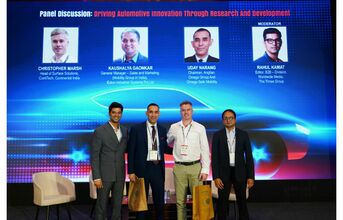
Marsh responded by underscoring the significance of design as the forefront of customer appeal, acknowledging that compromise on design might not always be straightforward. He went on to highlight Continental's commitment to developing a circular product with zero emissions. Marsh emphasised that OEMs prioritise sustainability across the entire product lifecycle, aspiring to achieve net zero emissions throughout the supply chain—from tier 4 suppliers to the OEM factory— and extending the conversation to the product's afterlife.
Kaushalya proposed that numerous technologies are actively contributing to sustainability. He pointed out examples such as cylinder deactivation and variable wall technologies, highlighting their matured status globally and their consideration in India. Additionally, he emphasised that existing technologies could be made more efficient by minimising wastage. From an electric vehicle standpoint, Kaushalya noted that improving design can lead to a reduction in copper content, thereby enhancing sustainability.
Rahul then directed a question to Uday, focusing on collaboration among research institutes, government bodies, and companies. Narang emphasised the utmost importance of such collaboration, stating that Omega Seiki Mobility has been established on this foundational principle. He advocated for national or local alliances, and international collaborations with United States, Europe, Taiwan, Japan, and Korea. According to Narang, India can align itself with these regions, leveraging the wealth of inventions already made.
Narang expressed anticipation, stating that in the initial months of 2024, he would showcase a development from India—a vehicle capable of covering 400 kilometres on a single charge of hydrogen.
He noted the continuous evolution in battery technology, citing his own experience: when he began, the battery charging time was 45 minutes, which later decreased to 15, and now it's down to 5 minutes. The future, he remarked, holds unpredictable wonders. Comparing it to an ultramarathon, he emphasised that everyone needs to participate collectively in the early stages, and while anyone has the potential to emerge victorious in the end, the overarching victory will be for India.
Rahul then posed a crucial question to the panellists, addressing the issue of a reluctance to allocate funds for research and development (R&D). Narang expressed his willingness to invest in R&D and noted that while significant spending is happening at the top levels, it's crucial for these investments to trickle down to tiers 2, 3, and 4. Drawing a comparison with Japan's heavy investments in innovations and new products, Narang observed a nascent change in India, attributing it to the emerging startup culture in the country.
Offering his personal perspective, Narang shared his ambition: for every product manufactured by a large company, he aims to manufacture five, emphasising that this is the key to growth. Furthermore, he challenged the perception that R&D always entails higher costs, asserting that one must continually think about "What's next?" to dispel the myth that R&D is invariably an added expense.
Regarding Continental, Chris highlighted the substantial investment the company makes in R&D. He pointed out that they have established a laboratory at their Germany plant specifically designed for extensive testing of products across various parameters, including elongation and durability. Chris underscored the critical role of R&D in the supply chain, given the high demand from OEMS and customer expectations regarding product longevity and warranties.
Continue Reading on Page 4


























